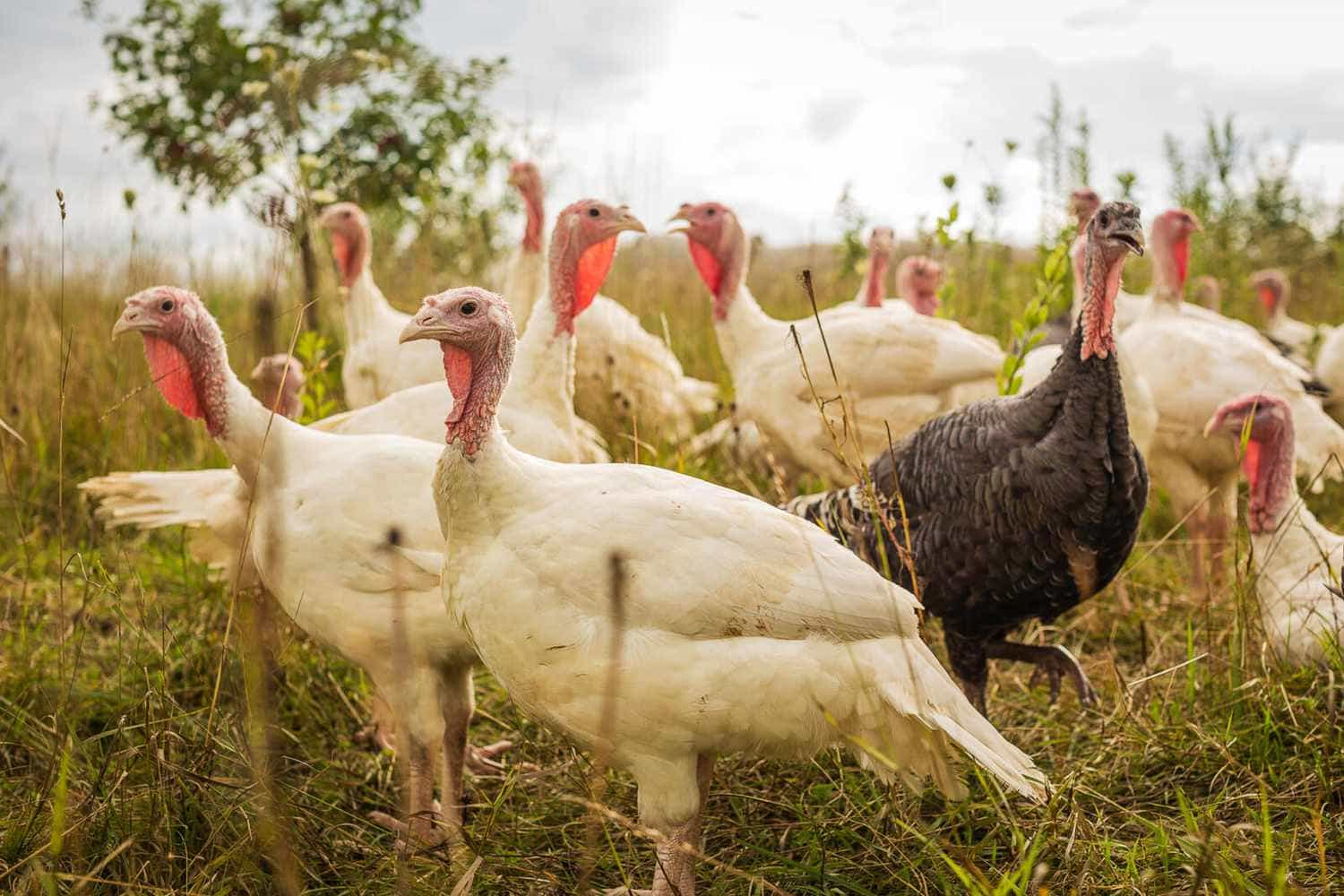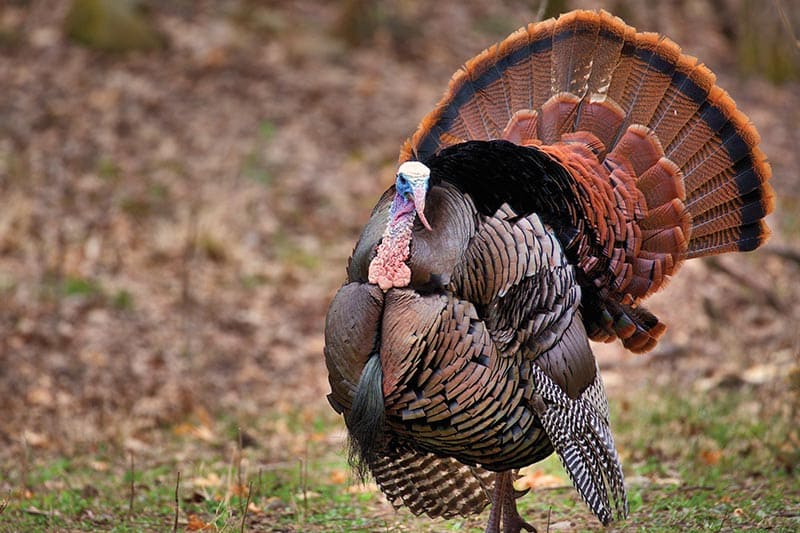Picture this: You’re walking through your local farmer’s market in November when you spot a magnificent bronze-colored turkey strutting confidently in a pen, its iridescent feathers catching the autumn sunlight. The farmer mentions it’s a heritage Standard Bronze—nothing like the pale, oversized birds you see shrink-wrapped in grocery stores.
This moment of realization hits many aspiring homesteaders: there’s a whole world of turkey breeds beyond the industrial norm, each with unique characteristics, flavors, and personalities that could transform your approach to raising poultry.
Whether you’re planning your first turkey flock or considering an upgrade from commercial breeds, understanding your options is crucial for success.
By the end of this guide, you’ll have the knowledge to select the perfect turkey breed that matches your goals, climate, and management style—plus you’ll discover why heritage breeds are experiencing a remarkable comeback among discerning farmers and food enthusiasts.
👉 Discover Top Egg-Laying Chicken Breeds for Your Backyard Flock
The Great Divide: Heritage vs. Commercial Turkey Breeds
Before diving into specific breeds, you need to understand the fundamental split that defines the modern turkey world. This isn’t just about size or color—it’s about two completely different philosophies of turkey breeding that affect everything from daily management to long-term sustainability.
Commercial Breeds: Built for Speed and Size
Commercial turkeys like the Broad-Breasted White dominate 90% of the market for one simple reason: they’re incredibly efficient at converting feed into breast meat. These birds can reach 30-45 pounds in just 14-18 weeks, making them economic powerhouses for large-scale operations.
However, this efficiency comes with significant trade-offs. Commercial turkeys cannot mate naturally due to their disproportionate breast size—they require artificial insemination to reproduce.
Their rapid growth often leads to leg problems and heart issues, typically limiting their lifespan to 20-26 weeks whether they’re harvested or not. They’re also less disease-resistant and have limited foraging abilities, requiring consistent high-quality feed and more intensive management.
Heritage Breeds: The Traditional Choice
Heritage turkeys must meet strict criteria defined by the American Livestock Breeds Conservancy. They must mate naturally, live long productive lives (often 5-7 years for breeding birds), and grow at a slower, more natural rate—reaching market weight in 26-30 weeks instead of 14-18.
This slower development allows heritage turkeys to develop stronger skeletal systems, better organ health, and more complex flavors. They’re superior foragers, more disease-resistant, and retain the intelligence and behavioral traits that made turkeys successful in the wild for millennia.
Understanding these behavioral differences is crucial for management success—heritage turkeys are naturally curious, social birds that establish complex pecking orders and prefer to roost high in trees rather than staying ground-bound.
The Heritage Hall of Fame: Eight APA-Recognized Breeds
The American Poultry Association recognizes eight heritage turkey varieties, each developed for different climates, purposes, and regional preferences. Understanding their origins helps predict how they’ll perform in your specific situation.
Standard Bronze: The Classic American Turkey
The Standard Bronze represents the quintessential American turkey experience. Developed by crossing European domestic turkeys with native Eastern wild turkeys, these birds showcase the beautiful copper-bronze plumage with green and blue iridescence that most people associate with traditional turkeys.
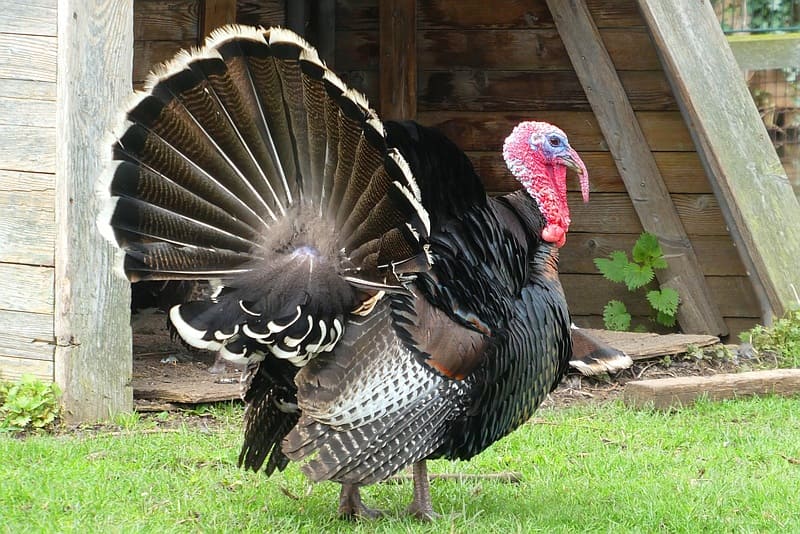
Toms typically reach 25-35 pounds while hens average 16-20 pounds, requiring 26-28 weeks to reach optimal market weight. Their temperament is generally calm and manageable, though individual personality varies considerably.
The meat quality delivers rich, traditional turkey flavor with an excellent dark-to-light meat ratio that many consider superior to commercial varieties.
Standard Bronzes are excellent foragers and retain strong maternal instincts, making them valuable for sustainable breeding programs.
Their main drawback is that dark pin feathers can be challenging to remove completely during processing, potentially affecting carcass appearance—though this rarely concerns direct-market producers whose customers value flavor over cosmetic perfection.
Bourbon Red: The Gourmet’s Choice
Named after Bourbon County, Kentucky, where they were developed in the late 1800s, Bourbon Reds consistently rank as the best-tasting heritage breed in blind taste tests. Their striking reddish-brown plumage with white wing and tail feathers makes them one of the most visually appealing varieties.
These birds reach 23-33 pounds for toms and 12-18 pounds for hens, requiring 26-30 weeks to develop optimal flavor complexity.
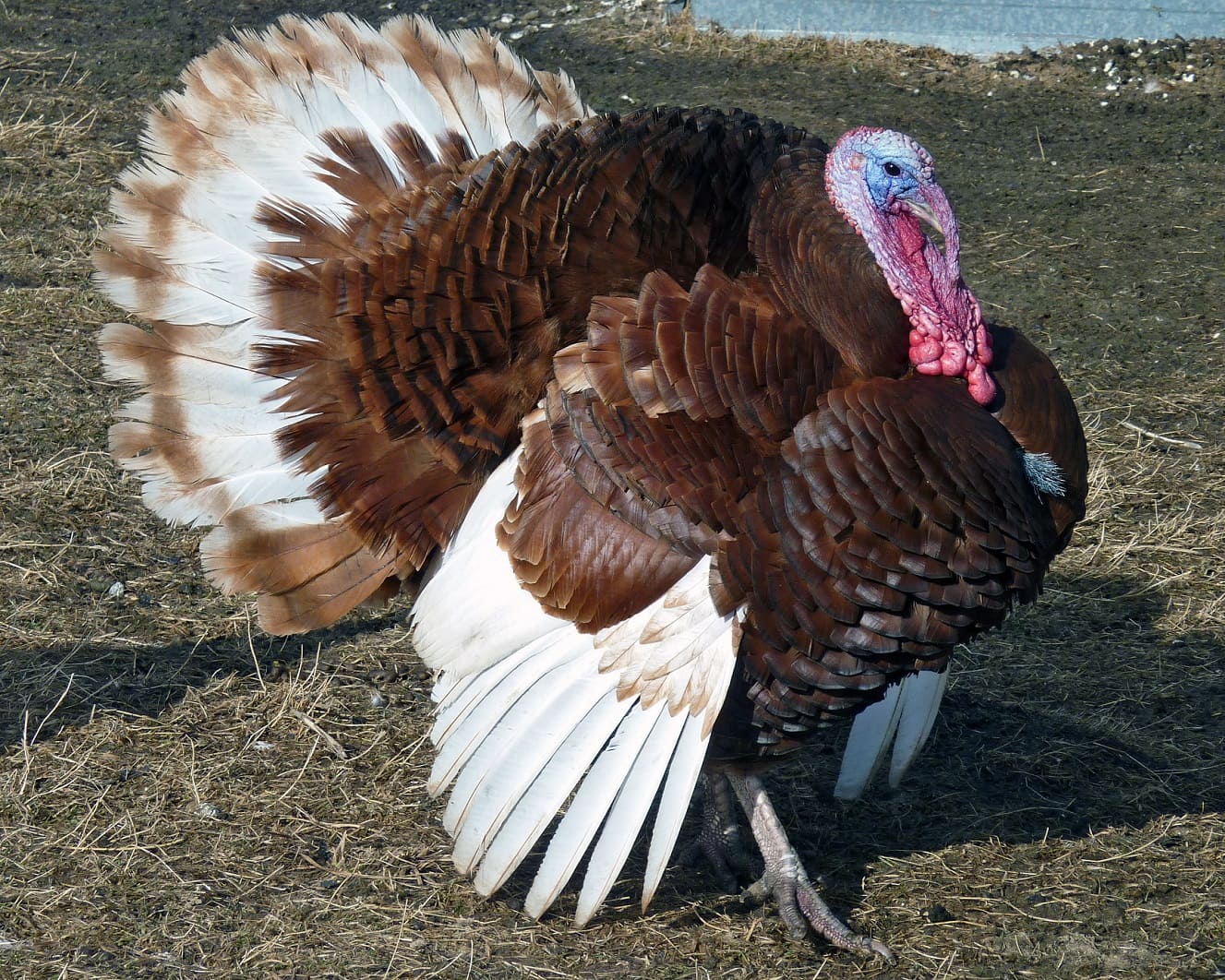
Their temperament is notably curious and social—they’re often described as being “underfoot” during feeding time, examining everything in their environment with apparent intelligence. This social nature makes them favorites among small-scale farmers who enjoy interacting with their birds.
The meat quality is exceptional, featuring tender texture and well-developed breast meat that maintains the rich, complex flavors characteristic of slow-grown heritage birds. Bourbon Reds excel as both meat birds and breeding stock, with hens showing strong maternal instincts and good egg production.
Narragansett: The New England Workhorse
Developed in Narragansett Bay, Rhode Island, these birds were the foundation of New England’s turkey industry before commercial breeds took over. Their striking pattern of black, gray, tan, and white feathers provides excellent camouflage and visual appeal that makes them favorites for agritourism operations.
Toms reach 22-30 pounds while hens average 12-18 pounds, maturing in 24-28 weeks.
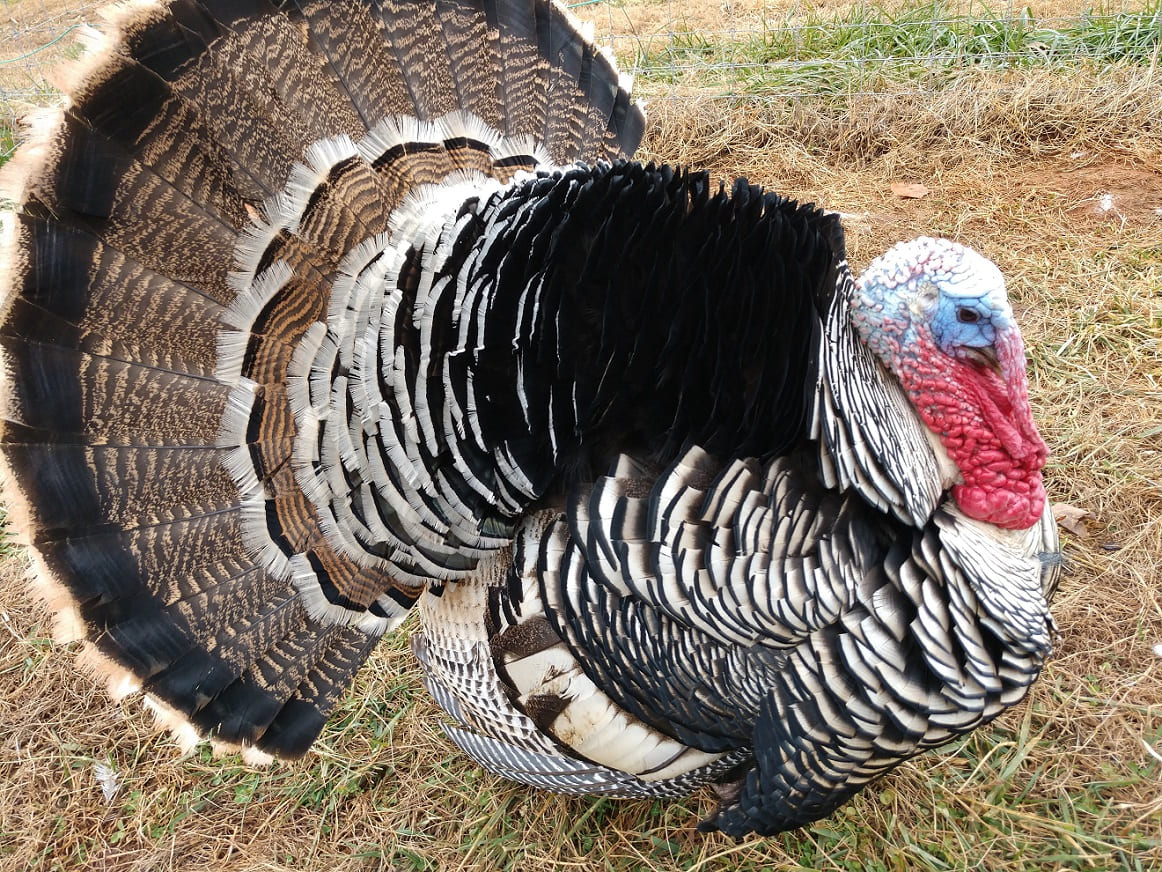
Their temperament is notably calm with excellent maternal abilities, and they show superior adaptation to cold climates—a trait selected for during their development in harsh New England winters. This cold-hardiness extends to their ability to forage effectively even in marginal weather conditions.
Narragansetts are particularly valued for their adaptability and strong maternal instincts. They’re prolific layers during their spring breeding season and excel in free-range situations where their foraging abilities reduce feed costs significantly.
White Holland: The Versatile Producer
One of the oldest heritage breeds, White Hollands were the primary commercial white turkey before the development of modern Broad-Breasted varieties. Their pure white feathers eliminate dark pin feather issues, making them the cleanest processing heritage breed available.
These substantial birds reach 25-36 pounds for toms and 16-20 pounds for hens, requiring 26-30 weeks to reach market weight.
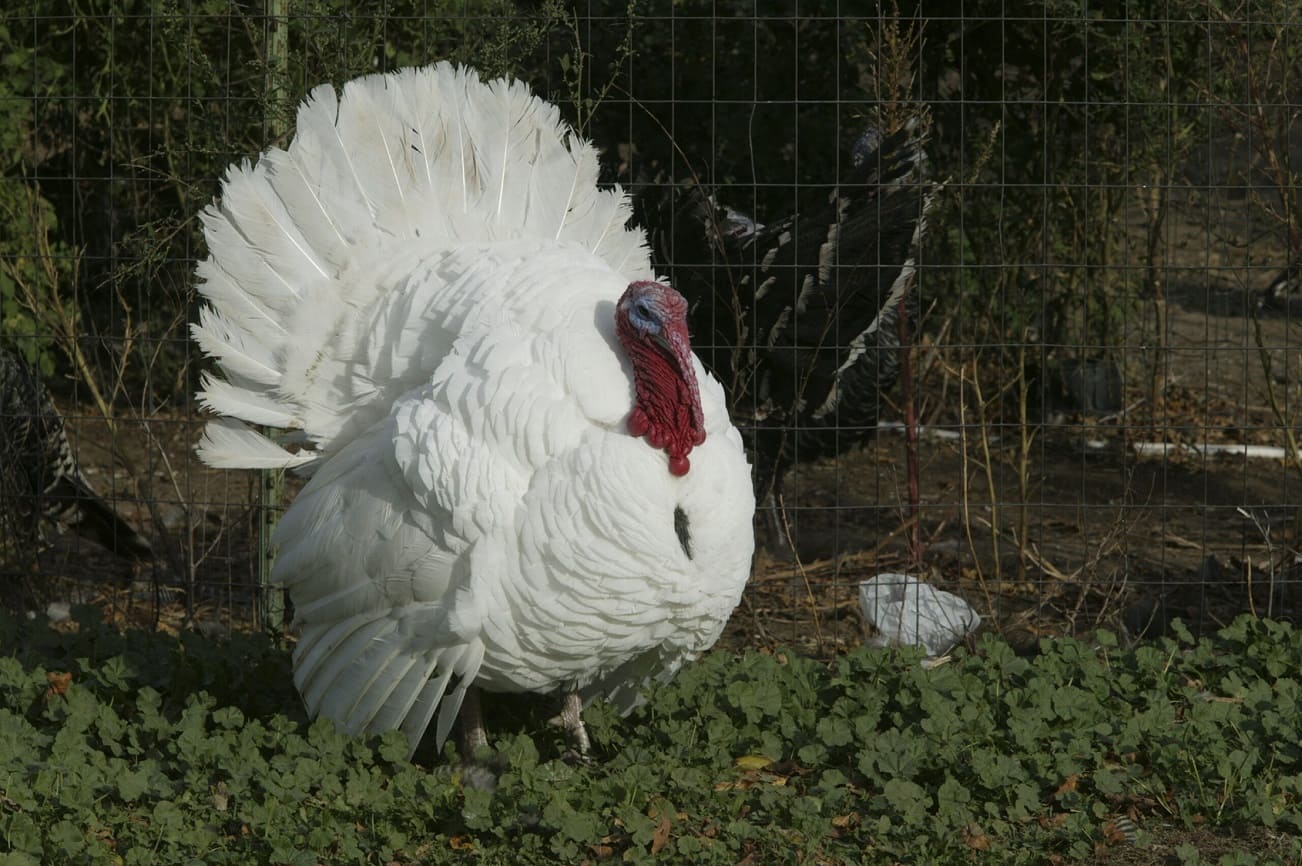
Their temperament is exceptionally calm, making them excellent for beginners who want to learn turkey management without dealing with flighty or aggressive birds. However, their size can sometimes lead to egg breakage when hens attempt to sit on nests.
👉 Discover 5 Surprising Ways to Use Eggshells in Your Garden
The meat quality offers mild flavor with good yield, and the white feathers create the clean carcass appearance that many consumers prefer. This makes White Hollands excellent choices for farmers targeting markets that prioritize appearance alongside heritage genetics.
Black (Spanish Black): The Historic Traveler
Black turkeys have perhaps the most interesting history of any breed. Originally brought from Mexico to Europe by Spanish explorers in the 1500s, they traveled back to America with European colonists and were crossbred with wild turkeys to create several other heritage breeds including the Bronze and Narragansett.
Reaching 23-33 pounds for toms and 14-18 pounds for hens in 28-32 weeks, these birds showcase lustrous black feathers with green sheen that creates stunning visual appeal.
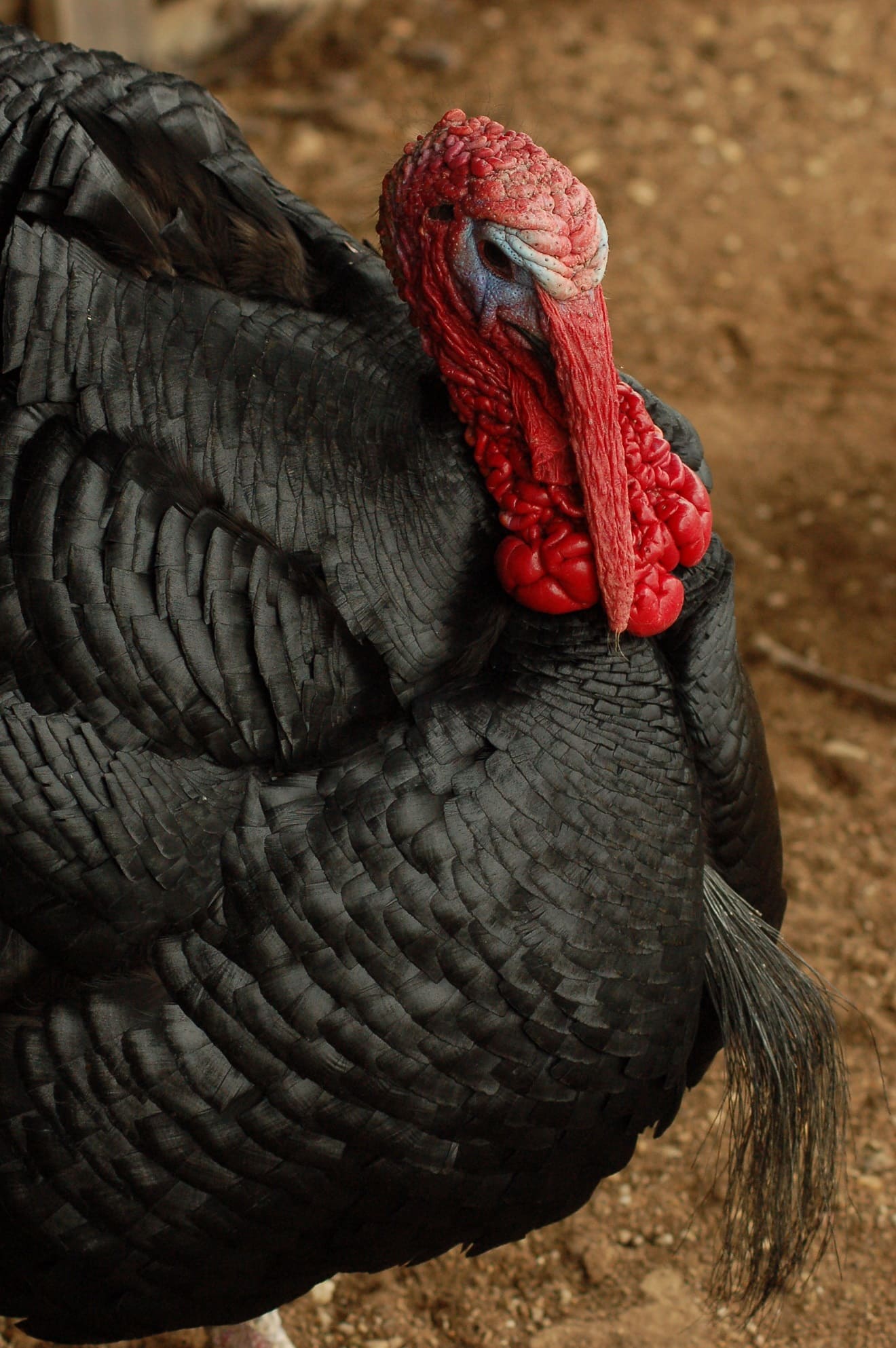
They’re generally calm and good foragers, with the distinctive characteristic of being one of the few heritage breeds that retains strong flying ability—an important consideration for containment planning.
Their historic significance appeals to heritage food enthusiasts, and their genetic contribution to other breeds makes them valuable for conservation breeding programs.
Royal Palm: The Ornamental Beauty
Royal Palms stand out as the most visually striking turkey breed, with their crisp white and black contrasting plumage creating an almost formal appearance. While beautiful, they’re primarily kept for exhibition, pest control, and small family meat production rather than commercial purposes.
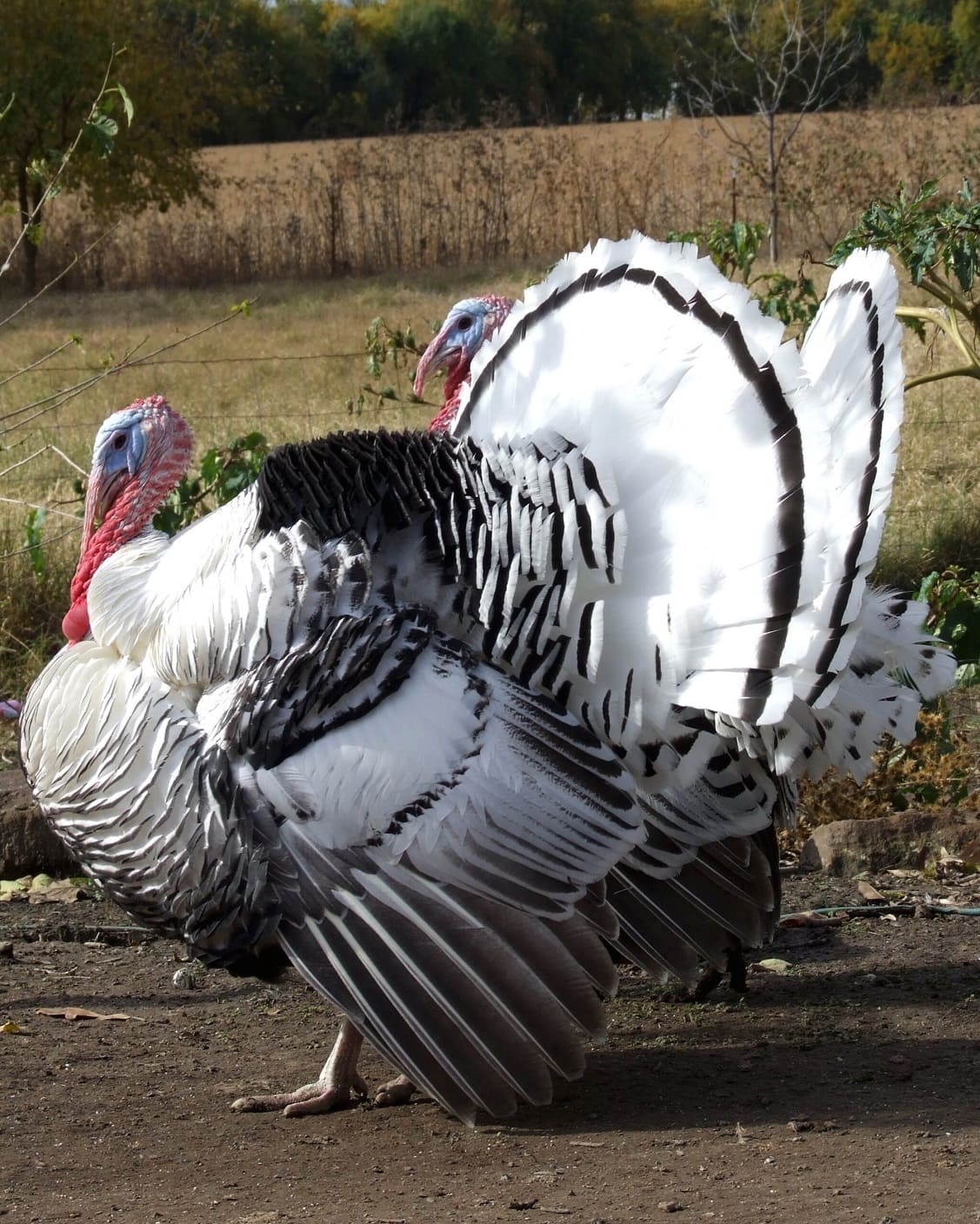
These smaller birds reach 16-20 pounds for toms and 10-14 pounds for hens in 26-30 weeks. Their temperament is docile and curious, with excellent flying ability that makes them superior for insect control but challenging for containment.
Their smaller size makes them ideal for families wanting fresh turkey without dealing with massive birds, though their breast development is less pronounced than meat-focused breeds.
Slate (Blue Slate): The Variable Beauty
Slate turkeys showcase the genetic diversity possible in heritage breeds. Their coloring can range from light lavender-gray to deep slate blue, with significant variation even within the same flock. This genetic diversity makes them interesting from a breeding standpoint but challenging for those seeking uniformity.
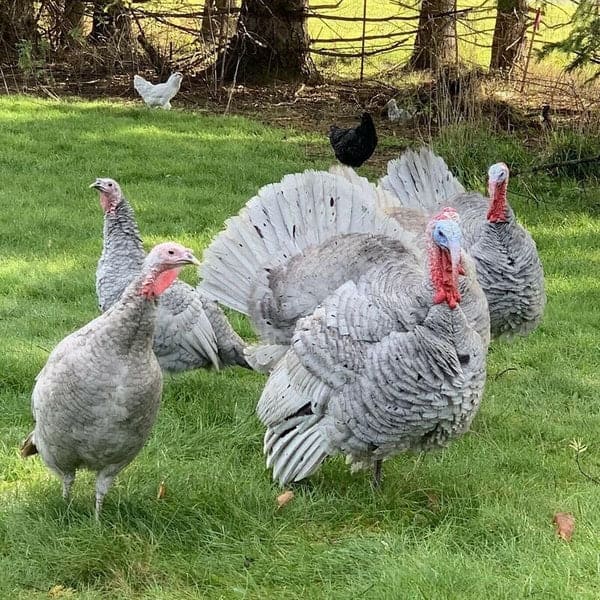
Toms typically reach 23-28 pounds while hens average 14-18 pounds, maturing in 26-30 weeks. Their temperament is generally calm though variable by individual, and the meat quality offers good flavor with firm texture. The color variation makes them popular with hobby breeders who enjoy the surprise element of unpredictable offspring coloring.
Beltsville Small White: The Family-Sized Solution
Developed by the USDA in the 1930s to meet consumer demand for smaller turkeys, Beltsville Small Whites were once the most popular turkey in America. Their smaller size makes them perfect for modern families and easier management situations.
These compact birds reach 17-21 pounds for toms and 10-14 pounds for hens in 24-26 weeks. Their temperament is less social than other breeds but still manageable, and they’re excellent egg layers with prolific breeding capabilities.
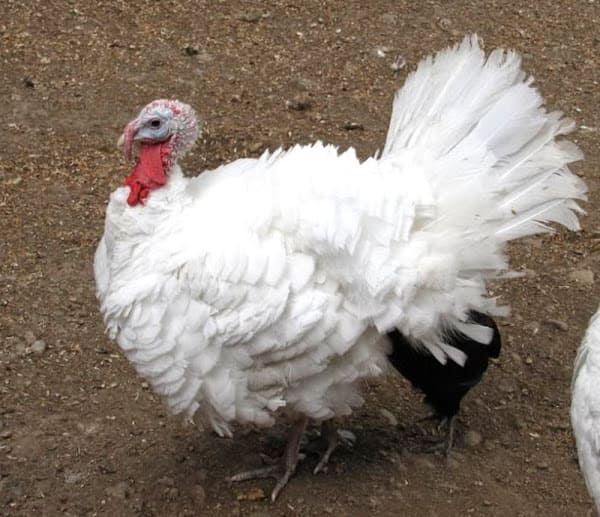
Unfortunately, authentic Beltsville Small Whites are now critically rare, making them difficult to obtain but valuable for conservation efforts.
Beyond APA Standards: Additional Heritage Varieties
Several non-APA varieties deserve consideration for specific purposes, particularly for homesteaders seeking unique characteristics or conservation opportunities. These breeds often represent regional specialties or varieties developed for specific purposes that didn’t achieve widespread recognition but maintain valuable genetic traits.
Midget White
Developed in the 1960s at the University of Massachusetts, these birds represent the smallest heritage turkey variety at 16-20 pounds for toms and 8-13 pounds for hens. They consistently rank at the top of taste tests despite their diminutive size, maturing in just 20-24 weeks.
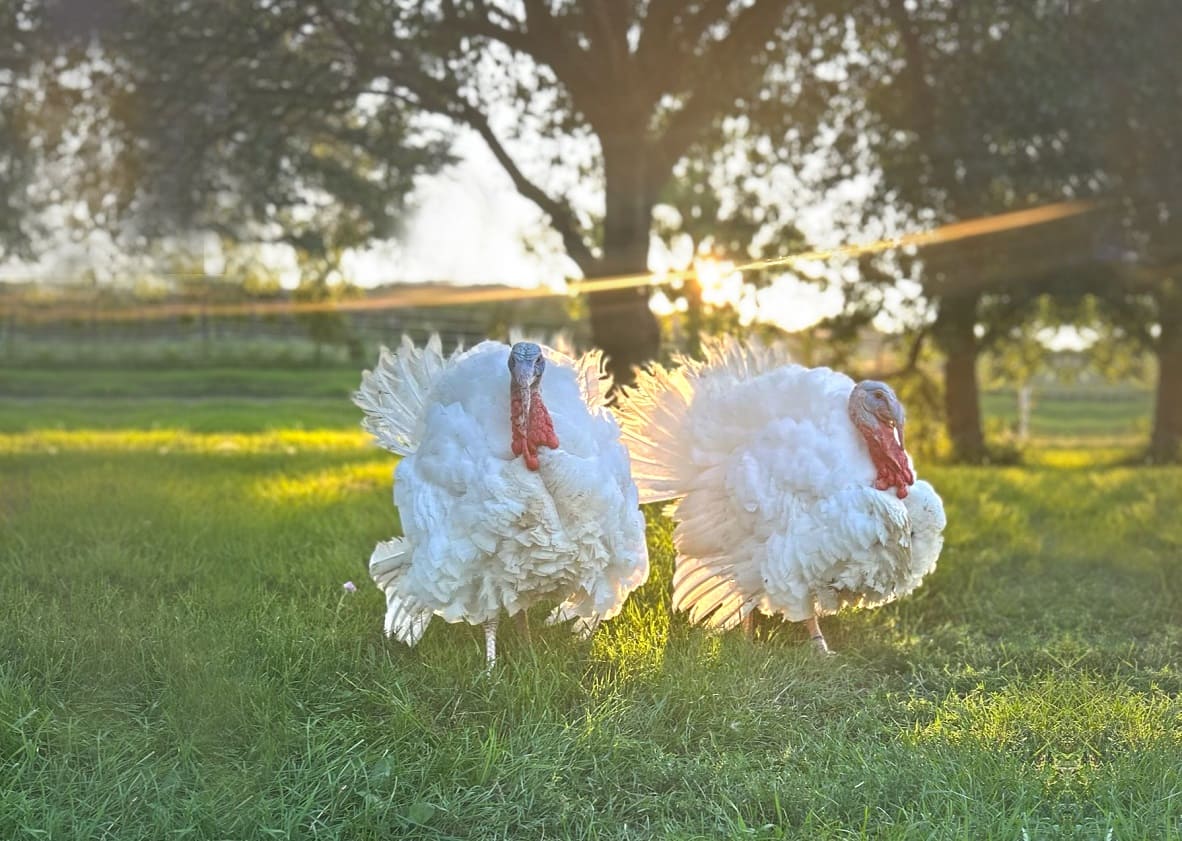
Their friendly, calm temperament makes them excellent with children, though their small size makes them fence-jumpers requiring secure containment. The breed nearly disappeared when the university flock was dispersed in 2005, making current breeding stock extremely valuable for conservation efforts.
Jersey Buff
Nearly extinct and then recreated, Jersey Buffs showcase beautiful reddish-buff coloring that commands premium prices in specialty markets. They’re calm, easy to work with, and ideal for hobby farms, though their rarity makes them expensive to acquire and important for conservation breeding.
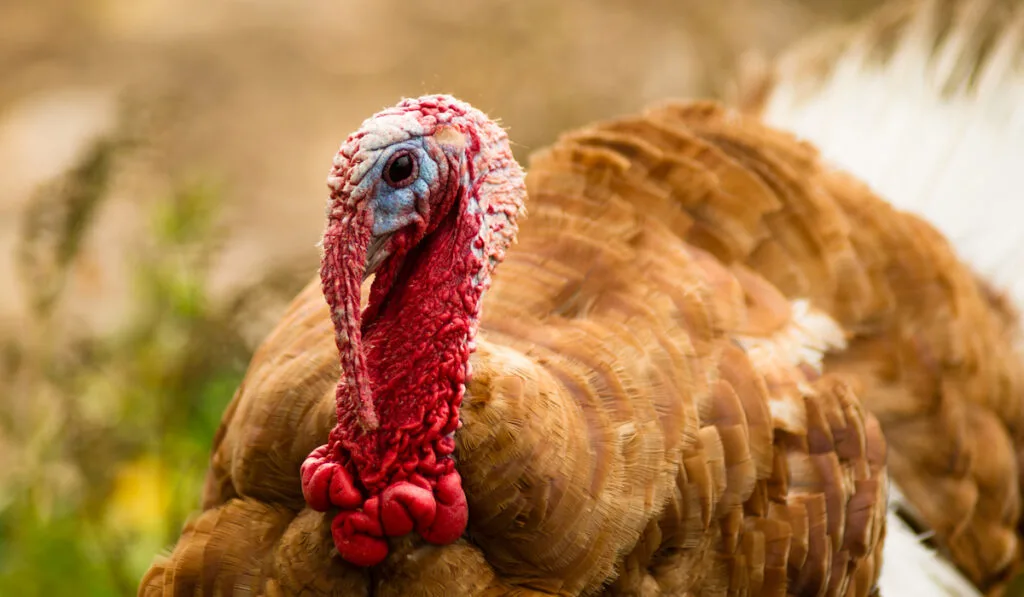
The original Buff variety was removed from the APA Standard in 1915 due to lack of interest, but the Jersey Agricultural Experiment Station recreated the type in the 1940s through careful breeding of Black, Bourbon Red, and Broad Breasted Bronze crosses.
Auburn Turkey
One of the rarest heritage varieties, Auburn turkeys represent a large heritage breed similar to Bronze but with distinctive reddish coloring rather than copper tones. These birds trace their lineage back several hundred years and are notably auto-sexing, meaning male and female poults can be distinguished by color patterns at hatching.
They’re excellent foragers with good maternal instincts, though their extreme rarity makes them challenging to locate and expensive to acquire. Current breeding populations are critically small, making them important for genetic diversity conservation.
Chocolate Turkey
A striking variety featuring solid milk chocolate-colored feathers, legs, and feet, Chocolate turkeys were common in the pre-Civil War South but nearly disappeared due to population losses during wartime. Despite their dark feathering, they reportedly dress cleanly and are known for exceptionally gentle temperaments.
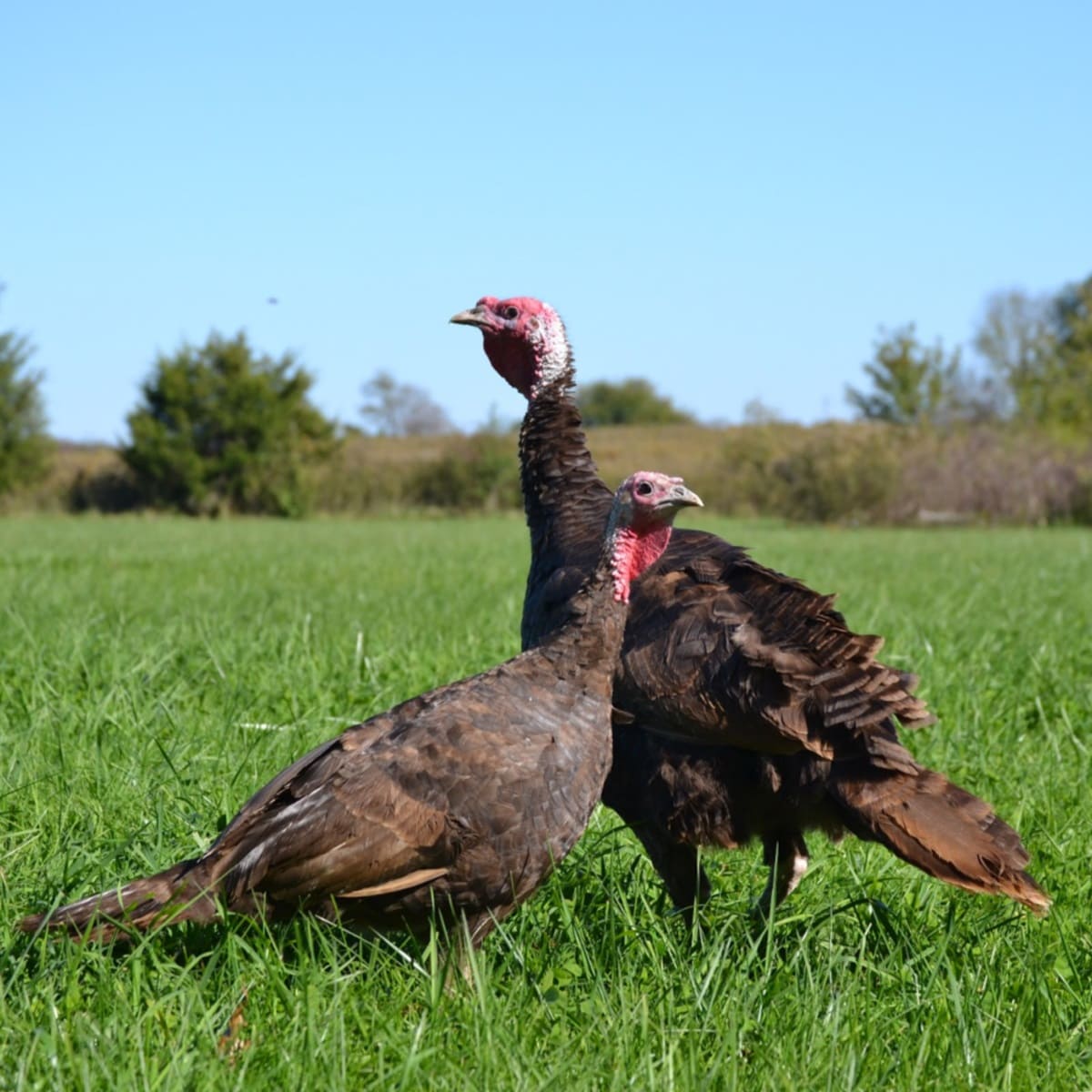
Toms can reach impressive weights of up to 33 pounds while hens typically average 18 pounds. Their rarity and unique coloring make them valuable for conservation breeding and specialty markets seeking unusual varieties.
Buff Turkey
The recreated Buff represents one of poultry’s most interesting conservation success stories. The original Buff variety was developed in the mid-Atlantic region and accepted by the APA in 1874, featuring beautiful cinnamon-brown feathers throughout with white wing feathers.
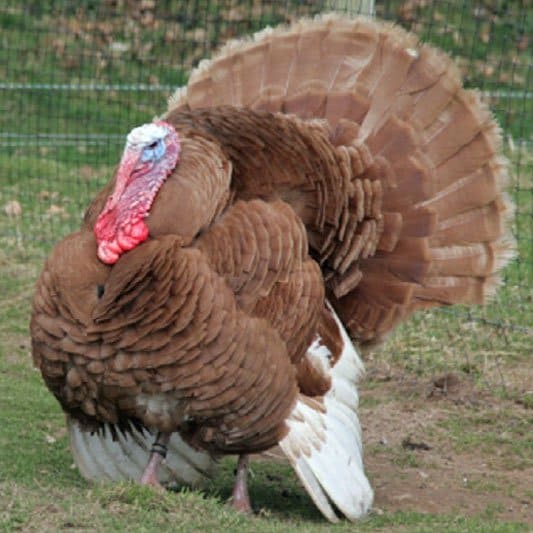
After going completely extinct in 1915, interest renewed in the 1940s when researchers at the New Jersey Agricultural Experiment Station methodically recreated the variety through selective breeding.
Modern Buffs are calm, easy to manage birds weighing 12-21 pounds depending on sex, though maintaining the proper buff coloration remains challenging for breeders.
Crimson Dawn (Black-Winged Bronze)
This unique variety results from a recessive genetic factor acting on the bronze pattern, creating birds that look like Bronze turkeys except for black primary flight feathers and secondary flights with white tips. While recognized in British Poultry Standards, they remain rare in North America.
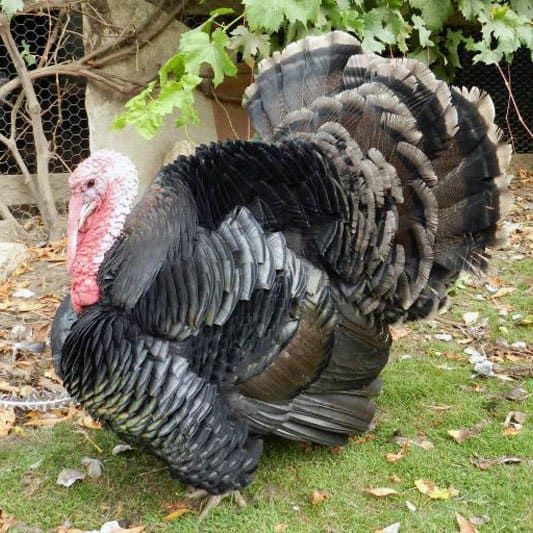
The variety showcases the genetic complexity possible in heritage turkey breeding and appeals to those interested in the scientific aspects of color genetics. Their appearance closely resembles wild turkeys but with more manageable domesticated traits.
Cambridge Bronze
Developed in England’s Cambridge region, these birds represent the European development of bronze-type turkeys parallel to American efforts. They feature the characteristic bronze coloring but with slightly different body proportions and feather patterns reflecting their British breeding origins.
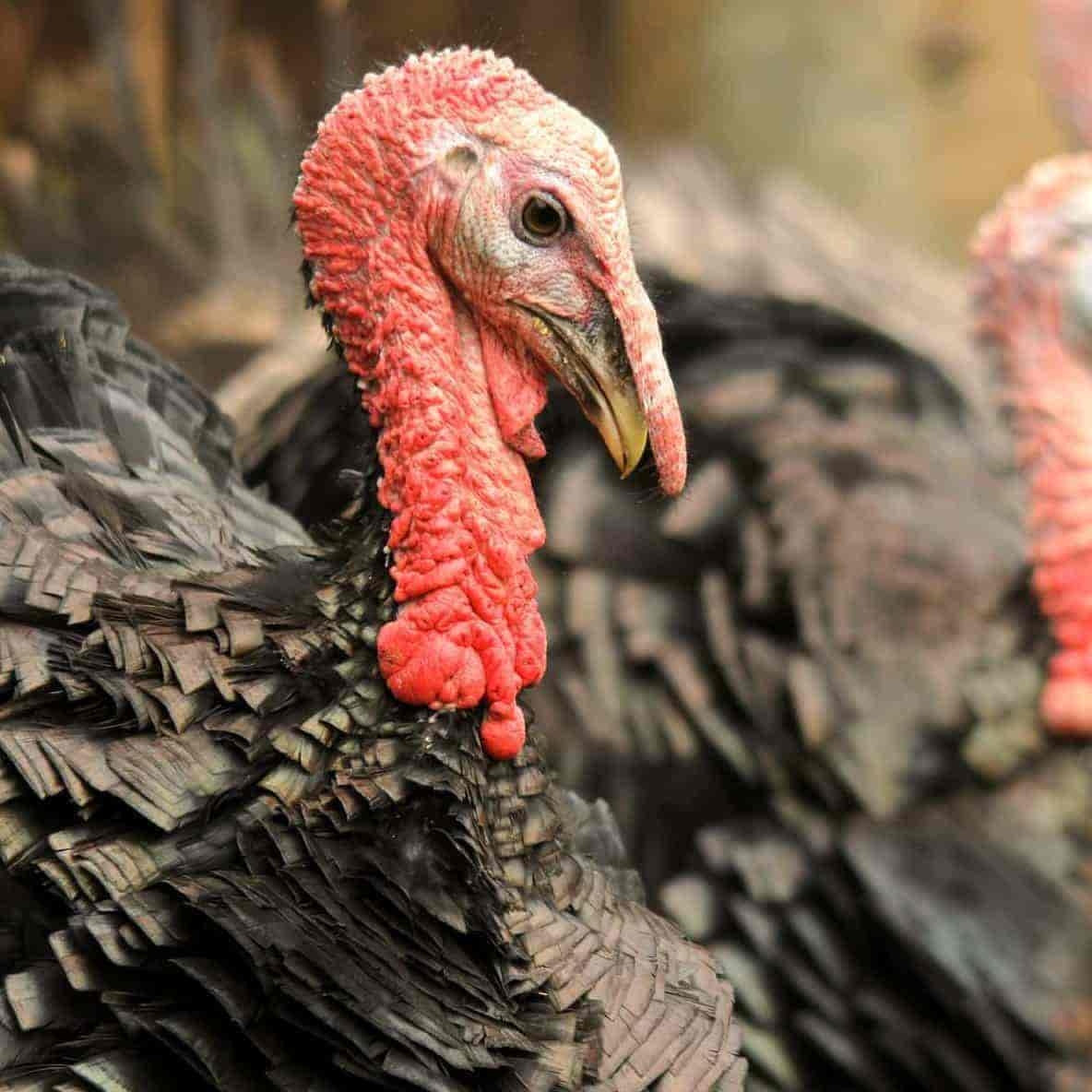
Cambridge Bronze genetics were historically important in developing some American broad-breasted lines, making them valuable for understanding the genetic foundations of modern turkey breeding.
Commercial Breeds: When Efficiency Rules
For operations focused purely on maximum meat production in minimum time, commercial breeds offer unmatched efficiency that heritage breeds simply cannot match. These varieties represent decades of intensive selection for rapid growth, feed conversion efficiency, and maximum breast meat production.
Broad-Breasted White: The Industry Standard
Representing over 90% of commercial production, Broad-Breasted Whites are engineered for rapid growth and maximum breast meat yield. They can reach 25-45 pounds in just 16-20 weeks with exceptional feed conversion ratios of approximately 2:1 under ideal conditions.
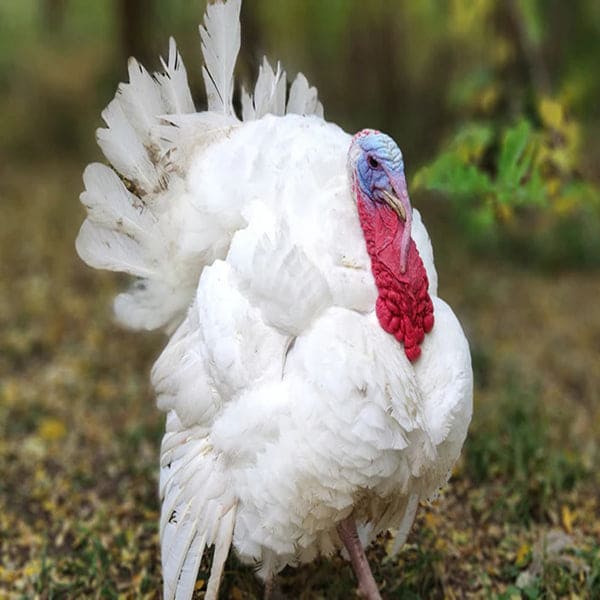
The advantages include fastest growth rates, highest meat yields, white feathers for clean processing, and widespread availability.
However, they cannot breed naturally, are prone to leg and heart problems, have limited lifespans, and possess poor foraging abilities that require intensive management. Their breast meat can constitute up to 70% of the carcass compared to 50% in heritage breeds.
Broad-Breasted Bronze: Heritage Appearance, Commercial Performance
These birds offer the visual appeal of heritage Bronze turkeys with commercial growth rates, providing a middle-ground option for those wanting traditional appearance with faster production.
They maintain the beautiful bronze coloring that appeals to consumers seeking a more “traditional” looking bird while delivering commercial-level growth and meat production.
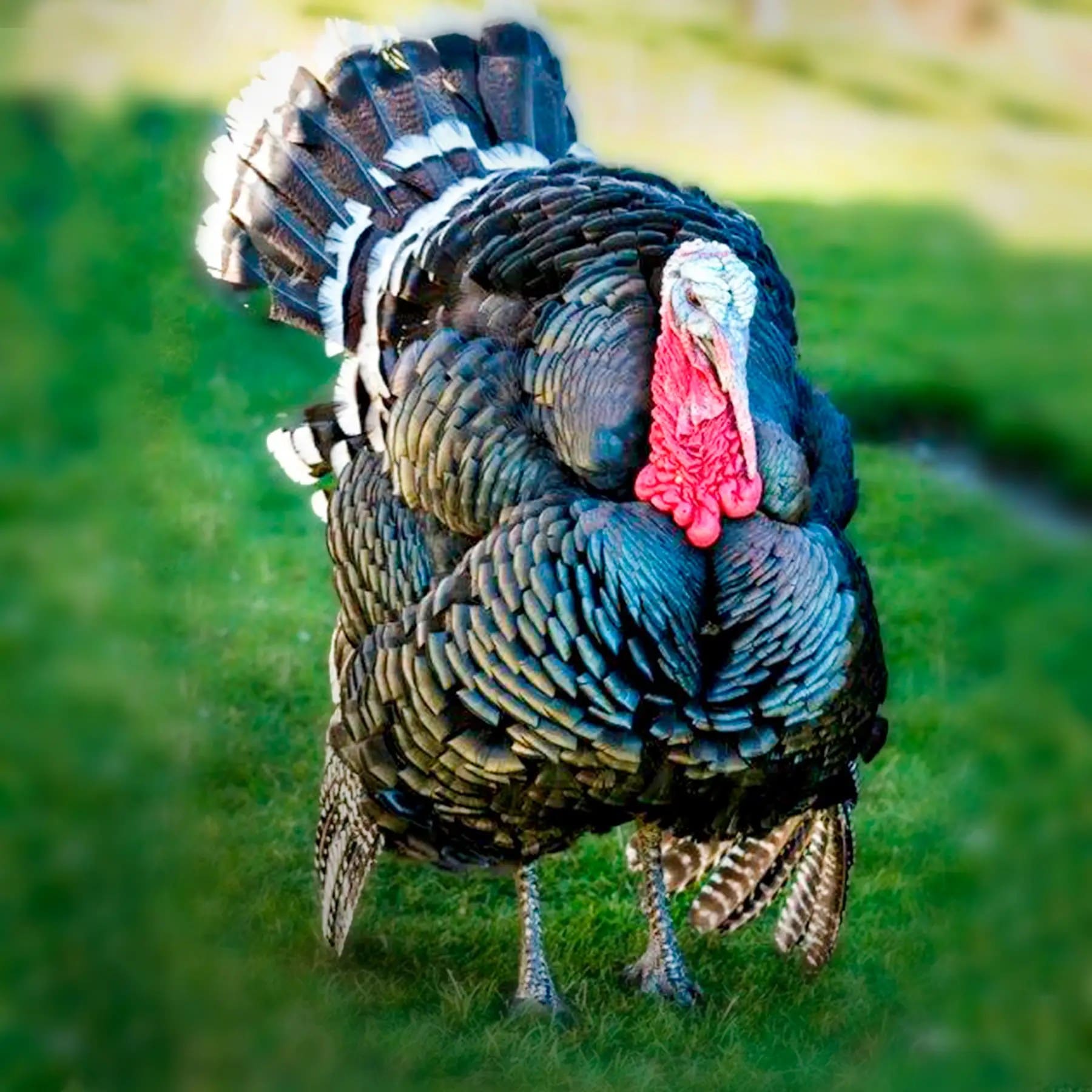
Orlopp Bronze: The Heritage-Commercial Bridge
The Orlopp Bronze represents a unique position in turkey breeding—a broad-breasted variety that maintains closer ties to original heritage genetics than modern commercial strains.
Developed from original bronze lines purchased by the Orlopp family in 1935, these birds offer slower growth than standard commercial varieties but better natural breeding ability than most broad-breasted types.
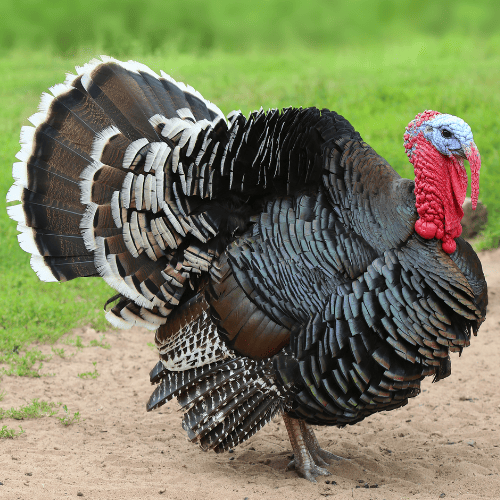
Toms reach approximately 39 pounds while hens average 23 pounds, taking about 20-22 weeks to reach market weight. Their bronze coloring provides traditional appearance, and they demonstrate better feed conversion ratios than many heritage breeds while maintaining some natural breeding capability that other broad-breasted varieties have lost.
Giant White: Maximum Size Production
Giant White turkeys represent the extreme end of commercial breeding, selected specifically for maximum size potential. These birds can reach weights of 45+ pounds for toms under optimal conditions, making them suitable for operations needing the largest possible birds for processing into parts rather than whole bird sales.
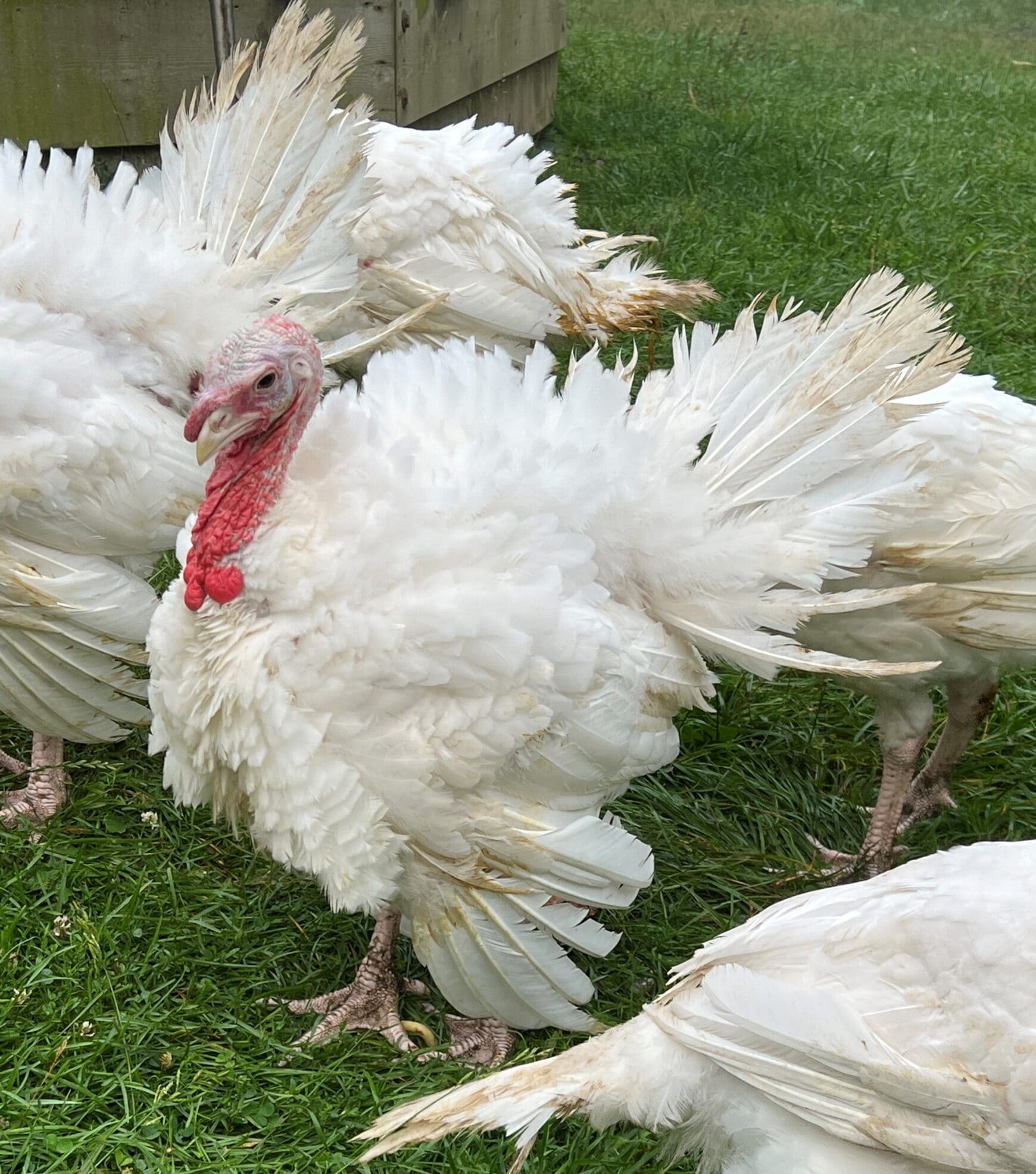
Their growth rates and management requirements mirror Broad-Breasted Whites, but their extreme size makes them even more dependent on careful management to prevent leg and mobility issues. They’re primarily used in commercial operations focused on further processing rather than whole bird markets.
Artisan Black: Premium Production Variety
Murray’s Artisan Black represents an attempt to bridge commercial efficiency with heritage characteristics. These birds grow slower than standard commercial varieties but faster than pure heritage breeds, reaching market weight in approximately 18-20 weeks while maintaining some of the flavor complexity associated with darker-feathered varieties.
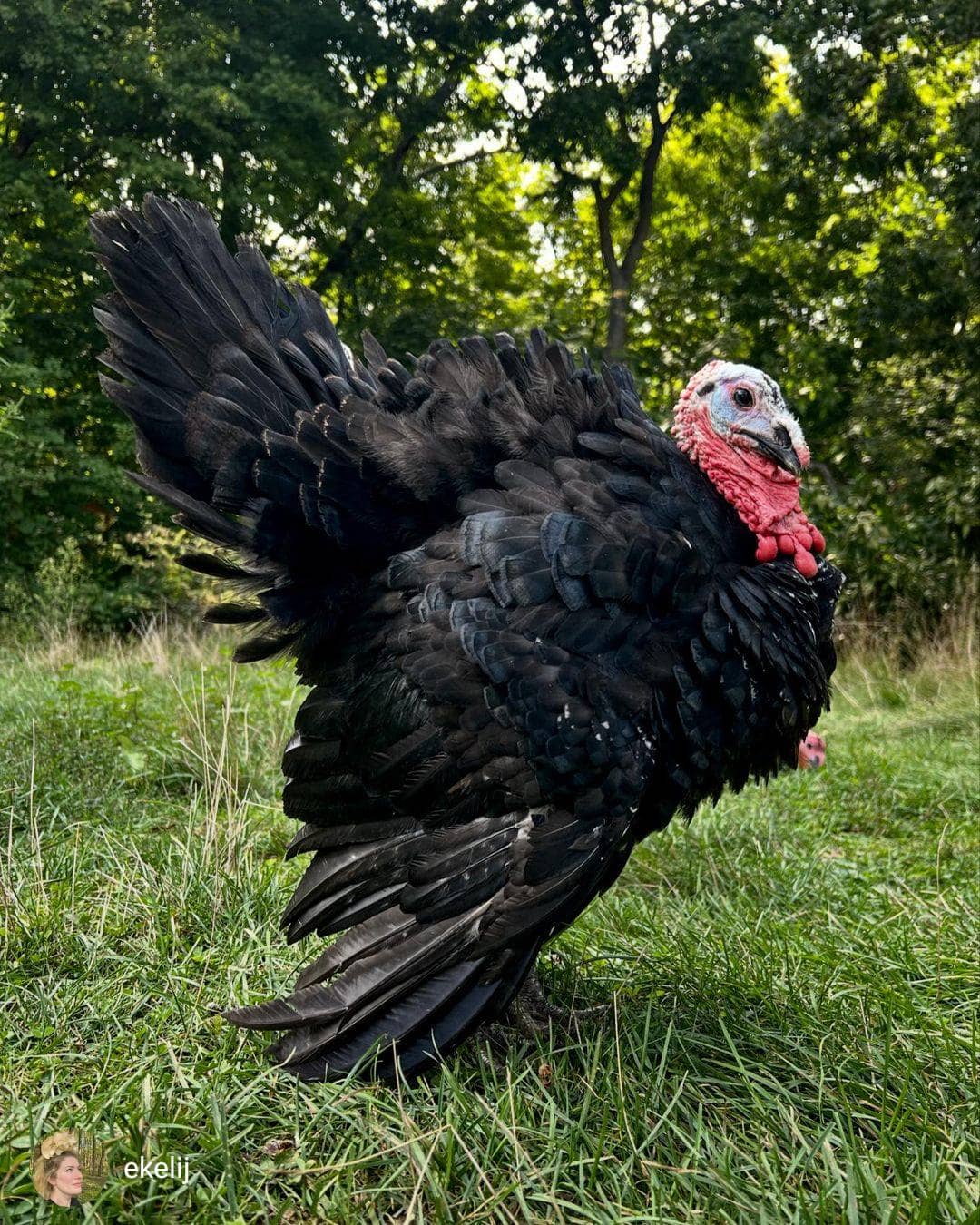
Toms average around 20 pounds at 20 weeks while hens reach 11-12 pounds at 16 weeks. They’re marketed as thriving in free-range settings better than standard commercial breeds while still providing the efficiency advantages that commercial operations require. Their darker feathering requires more careful processing to achieve clean carcass appearance.
Practical Management: What You Really Need to Know
Understanding Turkey Behavior and Social Dynamics
Turkeys are highly social birds with complex hierarchies that directly affect management success. Heritage breeds retain strong flocking instincts and establish pecking orders that remain stable once formed.
They communicate through a variety of vocalizations beyond the famous gobble—purring indicates contentment, alarm calls warn of danger, and assembly calls gather scattered flock members.
These birds are naturally curious and intelligent, investigating anything new in their environment. This trait makes them excellent foragers but can lead to trouble if they encounter hazards. Understanding that turkeys prefer to roost as high as possible—often in trees rather than coops—is crucial for housing design and predator protection strategies.
Seasonal Breeding and Management Cycles
Turkey reproduction follows distinct seasonal patterns that affect management throughout the year. Hens typically begin laying in March or April, producing 60-100 eggs over a 10-12 week period. Eggs require 28 days for incubation, with peak hatching occurring in late spring and early summer.
During breeding season, toms become more territorial and display frequently, which can affect flock dynamics. Hens may become broody and attempt to hide nests, requiring careful monitoring to ensure egg collection or protected hatching areas.
Understanding these cycles helps plan breeding programs and manage seasonal feed requirements effectively.
👉 Read the Ultimate Guide to Feeding Your Backyard Laying Hens for Maximum Egg Production
Housing and Infrastructure Requirements
Heritage turkeys need different housing than commercial breeds due to their flying ability and roosting preferences. Minimum space requirements include 1,000 square feet per bird for free-range operations, though more space generally produces healthier, happier birds.
Fencing must be at least 8 feet high or completely covered to contain heritage breeds, as most can easily clear 6-foot barriers. Roosting areas should accommodate their preference for high perches—12-15 feet off the ground if possible.
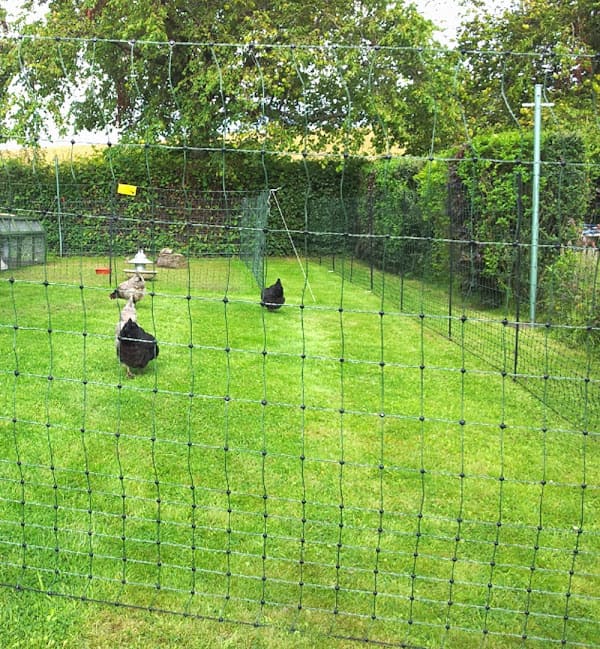
Shelter needs are relatively minimal since turkeys are quite cold-hardy, but protection from wind and precipitation improves health and comfort.
Water requirements are higher than chickens, with each adult turkey consuming 1-2 gallons daily during hot weather. Waterers must be designed to prevent contamination while allowing the birds to drink deeply, as turkeys need to submerge their beaks completely.
Predator Management Strategies
Turkey predator pressure varies significantly by region and setup, but common threats include coyotes, foxes, raccoons, great horned owls, and domestic dogs. Heritage breeds’ roosting behavior actually provides some protection, as they prefer to sleep 15-20 feet off the ground where most predators cannot reach them.
👉 Understanding Rooster Crows: More Than Just a Morning Alarm
However, ground predators pose serious threats during nesting season when hens may choose secluded locations for brooding. Electric fencing provides excellent protection for pastured flocks, while guardian animals like livestock guardian dogs can be effective for larger operations.
Motion-activated lighting and secure nighttime housing remain important components of comprehensive predator management.
Feed and Nutrition Through Life Stages
Turkey nutritional requirements change significantly throughout their life cycle. Poults need 28-30% protein for the first 8 weeks, transitioning to 20% protein for weeks 8-16, and 14% protein for maintenance. Heritage breeds can meet more of their nutritional needs through foraging, potentially reducing feed costs by 30-50% in good pasture situations.
Commercial breeds require consistent, high-quality feed throughout their accelerated growth period and cannot effectively utilize low-quality forages. Feed typically represents 60-70% of production costs for any turkey operation, making feed efficiency a crucial economic consideration.
Processing Timing and Logistics
Processing timing affects both meat quality and economics. Heritage breeds reach optimal flavor at 26-32 weeks when they’ve developed proper fat deposits and muscle maturity. Processing earlier yields smaller birds with less developed flavor, while waiting longer increases feed costs without proportional quality improvements.
Finding processors willing to handle heritage breeds can be challenging, as many commercial facilities are set up only for standard-sized birds. Mobile processing units or on-farm processing may be necessary in some areas. Processing costs typically range from $5-15 per bird depending on services included and local availability.
Choosing Your Perfect Turkey Breed: A Decision Framework
Selecting the right turkey breed requires honestly assessing your goals, resources, and constraints. The decision becomes clearer when you prioritize your objectives and match them to breed characteristics.
- For Maximum Meat Production:
Broad-Breasted Whites offer unmatched efficiency for feeding large families or commercial operations. They’re ideal when processing time, feed costs, and meat yield are primary concerns, though you’ll sacrifice flavor, breeding ability, and bird welfare considerations.
- For Superior Flavor and Sustainable Production:
Heritage breeds provide unmatched taste complexity and breeding sustainability. Bourbon Reds lead in flavor rankings, while Narragansetts excel in cold climates and Standard Bronze offers traditional appearance with reliable production.
- For Small Families and Limited Space:
Midget Whites deliver exceptional flavor in manageable packages, while Royal Palms provide ornamental value alongside moderate meat production. These breeds work well for families wanting fresh turkey without dealing with massive birds.
- For Conservation and Specialty Markets:
Rare breeds like Jersey Buff and Beltsville Small White command premium prices while contributing to genetic preservation efforts. These choices appeal to customers valuing heritage genetics and supporting conservation efforts.
Economic Realities: Understanding True Costs and Returns
Heritage turkey economics differ substantially from commercial operations. Initial poult costs range from $8-25 each versus $3-8 for commercial breeds, but heritage birds often sell for $80-200 dressed compared to $20-40 for commercial turkeys.
Feed costs over 26-30 weeks typically range from $40-80 per bird for heritage breeds, though effective pasture management can reduce this by 30-50%. Processing costs vary widely by region and services, ranging from $5-15 per bird for basic processing to $25+ for specialized heritage processing with premium packaging.
The key economic advantage of heritage breeds lies in breeding sustainability—once established, a breeding flock can produce dozens of offspring annually without ongoing poult purchases. This creates a significant long-term economic advantage for operations planning multi-year production cycles.
Commercial breeds offer faster cash flow with lower initial investment, making them attractive for beginning operations or those needing quick returns. However, they require annual poult purchases and cannot generate the premium pricing available in heritage markets.
Regional Considerations and Climate Adaptation
Different breeds excel in different climates based on their development origins. Cold-climate breeds like Narragansett and Standard Bronze handle harsh winters well due to their New England development, while breeds developed in moderate climates may require additional winter protection.
Heat tolerance varies significantly, with white-feathered varieties generally handling hot climates better than dark-feathered breeds. Shade provision and adequate water become critical in hot regions regardless of breed choice.
Local market preferences also affect breed selection. Some regions have strong heritage food movements supporting premium pricing, while others focus primarily on commodity pricing that favors commercial breeds.
Conservation Impact: Your Role in Preserving Genetic Diversity
Choosing heritage breeds directly supports conservation efforts for these endangered genetics. Current population levels place most heritage varieties in critical conservation categories, with some having fewer than 500 breeding birds nationwide.
Your decision to raise heritage breeds contributes to maintaining genetic diversity that may become crucial as climate change and disease pressures affect commercial poultry. These breeds carry genes for disease resistance, climate adaptation, and behavioral traits that took centuries to develop and cannot be quickly recreated if lost.
Frequently Asked Questions
- How much space do turkeys really need?
Heritage breeds thrive with pasture access—minimum 1,000 square feet per bird for free-range, though more space improves health and reduces feed costs. Commercial breeds can be managed in 50-100 square feet per bird in confinement, but this intensive approach requires careful management.
- Can turkeys and chickens live together?
While possible, it’s generally not recommended due to blackhead disease transmission risks and size differences that can lead to bullying. If mixed housing is necessary, provide separate feeding areas and monitor carefully for health issues.
👉 Find out: Can Chickens and Ducks Live Together?
- What’s the best beginner turkey breed?
White Holland or Bourbon Red offer excellent starting points due to calm temperaments and reliable characteristics. Avoid very rare breeds initially until you’ve mastered basic turkey management.
- How do I find quality heritage turkey breeders?
Contact the American Livestock Breeds Conservancy, breed-specific clubs, or state poultry associations for breeder directories. Evaluate breeders based on flock health records, genetic diversity, and their knowledge of breed characteristics.
- Do heritage turkeys really taste that much better?
Yes, the difference is significant. Heritage breeds develop complex flavors through slower growth and natural fat deposits that commercial breeds cannot achieve. However, proper cooking techniques are essential to showcase these flavor differences.
Your Path Forward: Making the Right Choice
The choice between heritage and commercial turkeys reflects your values, goals, and management capabilities. Heritage breeds offer superior flavor, breeding sustainability, conservation impact, and the satisfaction of working with intelligent, naturally-behaving birds.
However, they require longer production cycles, higher initial investments, and more complex marketing approaches.
Commercial breeds provide efficiency, predictability, and lower entry barriers, making them suitable for those prioritizing meat production over other considerations. The choice isn’t right or wrong—it’s about matching your selection to your specific situation and goals.
Start with a small flock to learn their requirements and determine what works best for your operation. Whether you choose the efficiency of commercial breeds or the complexity and rewards of heritage varieties, you’re participating in a tradition that connects you to thousands of years of human-turkey partnership.
The perfect turkey breed for your homestead is waiting to transform your understanding of these remarkable birds and potentially revolutionize your approach to sustainable meat production.
